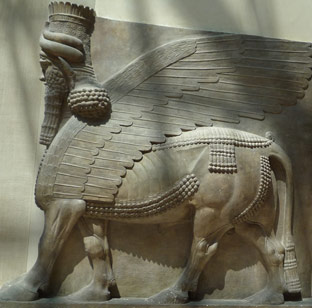Essentials: Assyria in the second half of the 8th century BC
This section provides a series of short overviews of the political and cultural contexts of the correspondence between king Sargon II and his top officials. Use the links below or in the menu to the left to select an article.

This colossal statue of a human-faced winged bull, a protective divine being known as lamassu to the Assyrians, is one of a pair guarding a gateway of Sargon's capital city of Dur-Šarruken. Today, it can be admired in the Louvre's Cour Khorsabad. Louvre, AO 19857; photo by Karen Radner. View large image.
We will continue to add materials to this section so watch out for new items.
Kings. This section introduces the kings who ruled Assyria in the second half of the 8th century BC: Tiglatpileser III and his two sons, Shalmaneser V and Sargon II.
Governors. The essays in this section focus on the implementation of Assyrian rule and raise questions such as, how did the king delegate power to his immediate subordinates, the magnates and the governors who ruled on his behalf in the provinces? And what role did long-distance communication play in the coherence of the Empire?
Diplomats. The Assyrian Empire controlled a number of vassal states that were nominally independent but expected to follow Assyrian policy; how was this achieved? The essays in this section explore the mechanisms of political, nonviolent interaction between Assyria and its neighbours.
Soldiers. This section deals with the army, today the most visible tool of Assyrian imperialism, thanks to the central role which the description of war plays in the Assyrian palace reliefs and royal inscriptions.
Countries and peoples. The essays in this section provide brief sketches of some of the other Near Eastern states and peoples shaping the political history of the late 8th century BC.
Cities. This section provides information on some of the most important cities of the Assyrian Empire and beyond.
Archives. These essays introduce our main sources for the royal correspondence of the 8th century BC, the letter archives found at Nineveh and Kalhu.
Content last modified: 20 Jul 2021.